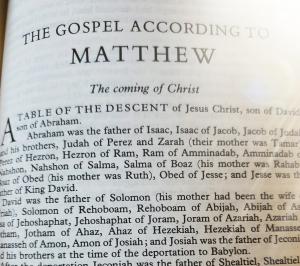 Preaching through the Gospel of Matthew every few years is an exercise in humility. This year, those of us using the Lectionary are back in the Gospel of Matthew for most of 2020. Looking back at my journals and notes, I find I expressed a great deal of assurance in my sermons. Looking back at my sermons and notes, I also find that I did not know what I was talking about. Each time I go through the gospels, I find something new, something I had not seen before, something that seems so clear. How could I have missed it?
Preaching through the Gospel of Matthew every few years is an exercise in humility. This year, those of us using the Lectionary are back in the Gospel of Matthew for most of 2020. Looking back at my journals and notes, I find I expressed a great deal of assurance in my sermons. Looking back at my sermons and notes, I also find that I did not know what I was talking about. Each time I go through the gospels, I find something new, something I had not seen before, something that seems so clear. How could I have missed it?
Sitz im Leben
Early in seminary, we learned the phrase, sitz im leben. It doesn’t sound like what it means. Sounds like a sneeze, or a piece of German furniture. But it refers to the “setting in life,” of the bible writer and the audience being written to. It is hard, because we are not familiar with the ancient world. We’re more familiar with our own. So it becomes easy to read the bible with contemporary assumptions that can often go unchecked.
Sometimes, the ancient reading is far too archaic for us to catch its meaning fully. Sometimes, it isn’t specific enough to answer all the questions we impose on it. Our world is the not ancient world. Technology, politics, economics have all created assumptions in us. What is normal to us, though, may never have been addressed in the bible. We know this. But we also forget this. Normal is not permanent.
Reading Like a Tourist
There are stereotypes about tourists. Especially American tourists. In a student blog for International Business Seminars, titled, How to Avoid Being an Ugly American Tourist, student Julia Meyer writes:
“The first and most important thing is to remember to keep an open mind while you are traveling. Remind yourself that you are in another person’s country and that you need to respect the local culture and language. Just as we often expect people to speak English in the United States, the locals will expect you to speak their language, so don’t get frustrated if you are struggling…”
This same principle works when reading the bible. It is not only a foreign culture and language, but a foreign time. Many of our experiences would anachronistic when inserted into the biblical world. The bible tends to say nothing about cell phones, electrical power grids, the (assumed) superiority of capitalism, and so much more.
Reimagining the Bible
Peter Enns encourages us to use wisdom in figuring out the bible. As the ancient text speaks to it’s current events, it may not always speak to ours. In, How the Bible Actually Works, Enns gives us the gist of his book in his subtitle: In Which I Explain How An Ancient, Ambiguous, and Diverse Book Leads Us to Wisdom Rather Than Answers―and Why That’s Great News. From finding new way to understand Passover regulations to what to do about slaves, women, and homosexuals, Enns guides bible readers to use wisdom, not just bible “verse grenades” to guide and not to end conversations.
Enns writes:
My point is that even though Paul’s words can’t be made to mean anything we like, once we dig into the cultural context a bit, we see that Paul meant something other than what we expect (pg 267).
What We Do Know
Often, the bible will get us into places and topics that are foreign to us. We can’t imagine being a desert traversing people. We can’t imagine hanging around King David’s court. We can’t completely grasp the drama of the Last Supper or the anguish of the Garden of Gethsemane. We can’t fully imagine what the Garden of Eden at the beginning is like, nor the restored earth at the end.
But what we do know is pretty large and encompassing. Love God, love people. Love our enemies. Love our neighbors as we love our selves. Forgive. Do justice, love mercy, and walk with God in humility. That’s a lot to work with right there.
The Gospel of Matthew Widens God’s Welcome
Matthew’s gospel will pick up on themes of hospitality, welcome, and inclusion. Matthew, as most scholars believe, was written for a thoroughly Jewish audience. This Jewish audience thought they knew who they were in God’s eyes. Some characters in Matthew’s story of Jesus don’t fit in, they are different, they are outsiders, unclean, or thought to be beyond God’s care, and thus beyond their responsibility.
Jesus, through Matthew’s telling of the story, most often seems mindful of his Jewish heritage. Jesus also is aware that that is not enough. The pivotal story of the Syrophoenician woman forces us to wonder if we really know who this Jesus guy is. Through her story, as well as others, we see the widening of God’s welcome. Leaving with us not just ancient ideas and principles, but a trajectory about where the kingdom of heaven is headed and what will the kingdom of God absorb and embrace next.
Follow along as I bounce through the Gospel of Matthew. Next time, the Sermon on the Mount, but maybe not the Beatitudes. They seem to get most of the attention. What does a 40,000 foot view reveal about Matthew chapter 5-7, that a verse by verse view does not?
I don’t know. Let’s find out.
Want Craig to come speak at your church, provide a workshop or a retreat? Send an invitation HERE
For more resources from Craig, check out The Missionplace.
Although we’re on hiatus, subscribe to
The All That’s Holy: Blue Collar Podcast available on iTunes.
Follow me and support me on my Patreon page.
















